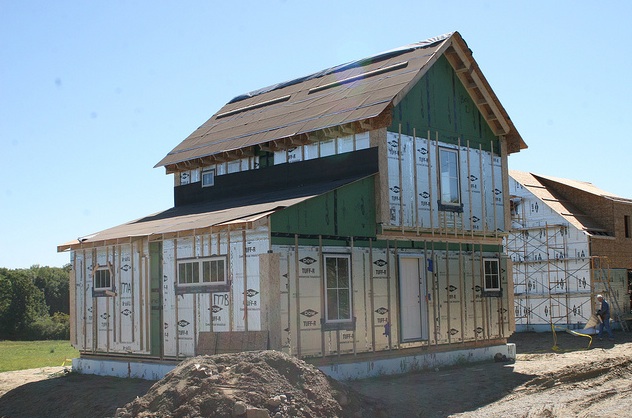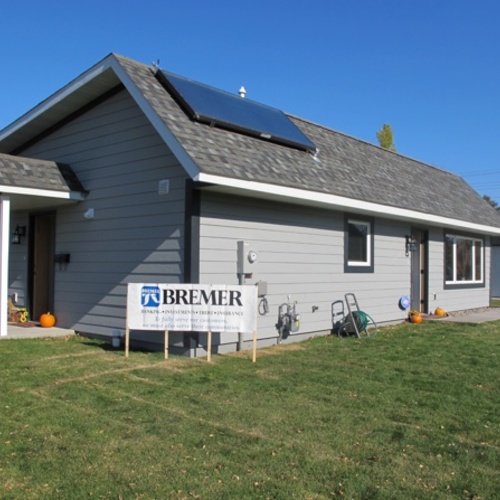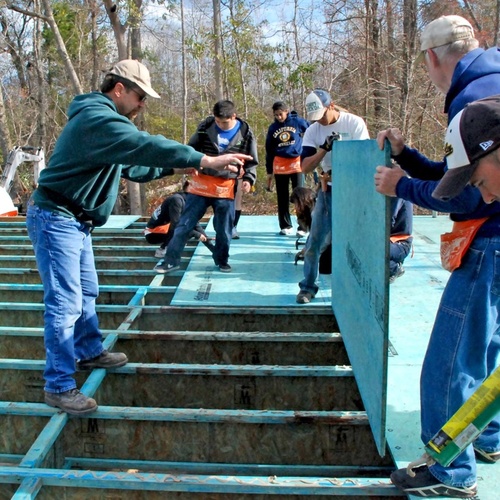
Image Credit: Katie Palmer
Image Credit: Katie Palmer The insulation system for the exterior walls is designed to provide R-60 thermal resistance. This is among the first Habitat homes aiming for Passive House performance while also using modular construction, says architect and Passive House specialist J. B. Clancy, a consultant on the project. The modules were hoisted into place in September 2010. The roof was installed in September.
Early this year, the Green Mountain Habitat for Humanity chapter, based in Charlotte, Vermont, had laid out plans for a three-home development that included one house built to Passive House standards. That project, scheduled to be the first of the three completed, now has a roof on it, and the homeowner, a single mother named Katie Palmer, seems to have all she can do to contain her excitement.
“I guess I’m picturing parts of our day, in this space,” Palmer, a single mother, recently told North Country Public Radio, shortly after a crane had hoisted the building’s primary modules into place on the foundation.
One of Green Mountain Habitat’s goals in venturing into construction of high-performance homes, a Passive House consultant on the project, Peter Schneider, explained back in February, is to use this first project as a teaching tool for other Habitat chapters and other affordable-housing developments.
A Habitat prototype
It’s estimated that a house built to similar dimensions and performance standards would cost about $50,000 more than a house built to code, the NCP Radio story noted. But Green Mountain Habitat for Humanity Director David Mullen told the station that, even though such a project requires more fundraising upfront, the Passive House building standard is especially well suited to Habitat’s low-income clients because of the energy savings the performance requirements deliver down the line.
The Charlotte house, adds Passive House specialist J. B. Clancy, of Albert, Righter & Tittmann Architects, in Boston, is among the very first Habitat projects to deploy modular construction in pursuit of Passive House performance. Getting the modular system to the required airtightness, adds the contractor for the project, Chet Paso, of Hartland, Vermont, is a matter of care and persistence.
“There’s nothing that sexy about it,” he told NCP Radio. “It’s just a lot of small details you’ve got to do extremely well.”
Weekly Newsletter
Get building science and energy efficiency advice, plus special offers, in your inbox.















6 Comments
additional costs
$50,000 - that is a lot of money (!). That is the first step to be done - reduce these costs; this can be done, we have done that in Europe, you should be able to do it in America.
Cost to Benefit?
I'm flabbergasted by that $50,000 number as well for a Habitat home. To me, by all means a proponent of both affordable housing construction and green-building efforts, this seems to be an irresponsible and excessive cost for a non-profit whose mission is to promote simple, decent, and affordable home ownership for low-income individuals.
While it is necessary for Habitat to consider the long-term benefits of added up-front costs when it comes to energy savings, it is unfair for an entity like Habitat to spend so disproportionately among the homes it builds. The bare-bones, low-cost, simple model of construction has been successful for Habitat and its benefactors over the years. Why now spend the equivalent of a second home's financing on something that amounts to a PR campain plus a marginal energy savings over a long period of time for a single homeowner'? There needs to be a middle ground.
so quick to judge? you know
so quick to judge? you know nothing about the actual numbers for this project and yet you are casting it out as a pr campaign. habitat is not just confined to a mission of creating low-cost homes, because their impact on this planet is far greater than that. As one of the top 10 homebuilders in the united states, they wield a hefty impact on all of us, not just low income families. The habitat project in this article is a model for environmentally sustainable low income home building, one that takes into account the environmental costs of our actions, something you clearly are not considering. Vermont has extremely high heating loads, and the standards to which this house has been built will save the homeowner money over the long run. If you think this is not in the homeowners long-term interest, then you are crazy.
i would like to add that i am not associated with habitat or this project.
spread the love - and the insulation out a bit
I keep coming back to the idea that although we should be building to 1/2 again above code and concentrating on the air tight details which can result in a house that uses very little energy to maintain. (Code is relatively weak in VT btw) What if the potential builder of a passive house whether an individual homeowner or an organization such as Habitat, put a large part of that 50k into weatherization and insulation programs where it could go towards saving energy in 4 or 5 other homes. Wouldn't that be much more righteous? Much less glam of course but definitely the higher moral ground.
bob - http://www.swinburnearchitect.com
Where is the Love
I agree with Wolfgang and his comment. If the house is to be inline with other passive houses buildt in USA it would cost about to 10 to 15% more than standard prices. The most at 15% it would be around $30,000 more. That price is without renewables. If the house cost is with all the renewables it maybe $50,000 because of the cost for solar thermal and solar PV. It would be a net zero if that is the case. I still think it is higher than it should be, but good job anyway Green Mountain Habitat for Humanity! I do know that there is a learning curve in all manufacturing of passive houses and we need to take this in account too. Prices should drop as the learning curve levels out so keep going. One of the ways that you could improve the price is panel construction so that you could keep the labor down from the factory with volunteer labor. That said my hats off to all the people who were involved and again keep up the good work!.
A challenge for Don
Don,
If you have built a Passivhaus building in Wisconsin, and the cost of the house you built was only 10% or 15% more than conventional construction, please share your cost book with us so we can learn how you did it! I'm skeptical.
Once you buy those Canadian triple-glazed windows, the thick foam under the foundation, the $3,000 HRV, and maybe the special exterior doors ... we're not talking 10% or 15%. But hey -- if you did it, tell us all about it, and we'll celebrate your achievement.
Log in or create an account to post a comment.
Sign up Log in